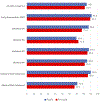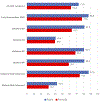Gender Differences in Visual Functioning Questionnaire Scores among Patients with Age-Related Macular Degeneration
- PMID: 35848204
- PMCID: PMC9903959
- DOI: 10.1080/09286586.2022.2084756
Gender Differences in Visual Functioning Questionnaire Scores among Patients with Age-Related Macular Degeneration
Abstract
Purpose: To examine gender differences in visual functioning using the National Eye Institute Visual Functioning Questionnaire-25 (VFQ-25) in a Colorado cohort of patients with age-related macular degeneration (AMD).
Methods: A retrospective cohort study was conducted using a registry of AMD patients who attended the Sue Anschutz-Rodgers Eye Center (2014 to 2019). Demographic, clinical, and image data were collected, and AMD was categorized as Early/Intermediate AMD, or unilateral/bilateral neovascular (NV) AMD, geographic atrophy (GA), or Both Advanced using the Beckman Classification. Each patient completed the VFQ-25, which evaluates visual functioning, generating a composite score and subscale scores for vision-specific activities. Univariate and multivariable general linear models were used to estimate the associations between gender and VFQ-25 scores with parameter estimates (PE) and standard errors (SE).
Results: Among 739 patients with AMD, 294 (39.8%), 115 (15.6%), 168 (22.7%), and 162 (21.9%) were diagnosed with Early/Intermediate AMD, GA, NV AMD, and Both Advanced, respectively. Adjusted for AMD classification, age and habitual visual acuity in the better-seeing and worse-seeing eyes, female gender was not significantly associated with lower composite VFQ-25 scores (PE (SE): -1.2 (0.9), p = .193), and was significantly associated with reportedly worse ocular pain and driving subscale scores (PE (SE): -4.6 (1.0), p < .0001 and -9.1 (2.1), p < .0001, respectively).
Conclusion: Gender plays a role in reported driving activities and ocular pain among patients with AMD. This may need to be accounted for in future research related to the use of VFQ-25 for AMD.
Keywords: Age-related macular degeneration (AMD); NEI VFQ-25; gender; visual functioning.
Conflict of interest statement
Disclosure statement
No potential conflict of interest was reported by the author(s).
Figures
Similar articles
-
Anti-vascular endothelial growth factor biosimilars for neovascular age-related macular degeneration.Cochrane Database Syst Rev. 2024 Jun 3;6(6):CD015804. doi: 10.1002/14651858.CD015804.pub2. Cochrane Database Syst Rev. 2024. PMID: 38829176 Free PMC article.
-
Antioxidant vitamin and mineral supplements for slowing the progression of age-related macular degeneration.Cochrane Database Syst Rev. 2017 Jul 31;7(7):CD000254. doi: 10.1002/14651858.CD000254.pub4. Cochrane Database Syst Rev. 2017. Update in: Cochrane Database Syst Rev. 2023 Sep 13;9:CD000254. doi: 10.1002/14651858.CD000254.pub5. PMID: 28756618 Free PMC article. Updated.
-
Surgery for cataracts in people with age-related macular degeneration.Cochrane Database Syst Rev. 2017 Feb 16;2(2):CD006757. doi: 10.1002/14651858.CD006757.pub4. Cochrane Database Syst Rev. 2017. PMID: 28206671 Free PMC article.
-
Antioxidant vitamin and mineral supplements for slowing the progression of age-related macular degeneration.Cochrane Database Syst Rev. 2023 Sep 13;9(9):CD000254. doi: 10.1002/14651858.CD000254.pub5. Cochrane Database Syst Rev. 2023. PMID: 37702300 Free PMC article.
-
Aflibercept for neovascular age-related macular degeneration.Cochrane Database Syst Rev. 2016 Feb 8;2(2):CD011346. doi: 10.1002/14651858.CD011346.pub2. Cochrane Database Syst Rev. 2016. PMID: 26857947 Free PMC article.
Cited by
-
Relationships between Patient-Reported Outcome Measures and Clinical Measures in Naïve Neovascular Age-Related Macular Degeneration Patients Treated with Intravitreal Ranibizumab.Pharmaceuticals (Basel). 2024 Jan 25;17(2):157. doi: 10.3390/ph17020157. Pharmaceuticals (Basel). 2024. PMID: 38399372 Free PMC article.
References
Grants and funding
LinkOut - more resources
Full Text Sources


